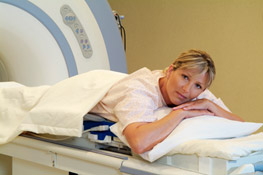Uterine Fibroids (also referred to as myoma, leiomyoma, leiomyomata, and fibromyoma) and Adenomyosis affect almost 50% of women of childbearing age, and some fibroids can be symptomatic. Talk to your Doctor if you think your symptoms are related to fibroids and to discuss various treatment options.
- No incisions are needed
- No hospital stay
- Quick recovery time, usually a next-day return to normal life
MRgFUS is a safe, Non-Surgical procedure for Uterine Fibroids.
(Please see HERE for more information.)
MR guided Focused Ultrasound (MRgFUS) treatment focusing high frequency sound waves (FUS) for heating and tissue ablation without damaging nearby tissue or tissues that the beam passes through.
FUS will be guided by MRI for precise control.

Only your physician can diagnose fibroids.
If you are experiencing any of the following symptoms of fibroids, you may wish to speak with him or her:
During your gynecological examination, your doctor will check the size of your uterus.
If it feels enlarged, your doctor may order an abdominal or transvaginal ultrasound or a magnetic resonance (MR) imaging session, which can confirm the presence, location and size of fibroids.
After identifying the size and location of your fibroids, and possibly after other diagnostic tests, your doctor may be able to rule out other conditions, advise you of your options and recommend a course of treatment for fibroids.
You will need to make a consultation appointment with one of our staff.
Based on your medical history, the size and location of your fibroid and other factors, he or she will determine if you are a suitable candidate for ExAblate treatments.
If you require treatment for your fibroid related symptoms, but want to avoid surgery and preserve your uterus, we will be happy to arrange a consultation with you.
A physician will ask you questions about your fibroid symptoms, general health and medical history.
You will also have routine blood work, an internal gynecological examination and MR imaging of your fibroids.
Based on this information, the physician will decide if you are a candidate for ExAblate.
Your physician will determine if your fibroids are suitable for treatment.
ExAblate can be used for submucosal, subserosal, and intramural uterine fibroids.
These are terms that are used to describe the location of the fibroid within the uterus.
More than one fibroid can be treated.
Fibroids that are pedunculated (hanging from a stalk), in close proximity to sensitive organs (such as bowel or bladder), or in a location inaccessible by the focused ultrasound may be untreatable.
In general, people who cannot go into an MRI will not be able to have the ExAblate treatment – this includes patients with metallic implants, patients who are claustrophobic, and patients who are allergic to the contrast agent, a dye used to see blood vessels during MR imaging.
Your physician will discuss these with you.
Your doctor is the best person to talk to about this.
Depending on how the surgery was performed, patients who have scar tissue on their abdomen from myomectomy or a previous surgery/C-section may not be eligible for the treatment since focused ultrasound is not indicated when large scar tissue is present.
Uterine Artery Embolization involves the injection of microbeads made of poly-vinyl alcohol or other materials that block the small vessels of the fibroid and uterus.
There were no patients with previous UFE/UAE treatment in the previous clinical studies, and the risks are unknown at this time.
Your physician would be the best person to discuss treatment alternatives with you. Other available treatments are:
One of the attractions of MRgFUS treatment is that by avoiding hysterectomy it can keep fertility options open.
As yet there are still relatively small numbers of reports cases (approximately 150 successful pregnancies around the world) but indications are that MRgFUS may be a safer option than other types of fibroid treatment if future pregnancy is desired.
We would however advise that you wait until after your 6 month follow up MRI scan before trying to conceive.
Contacting us is your first step for diagnosis and treatment. To make an appointment or address any questions, please call us or send a message from the following form.
Our co-ordinator will arrange appointments and answer your questions Siobhan Tuohy, Patient Co-Ordinator (03) 9818 9400
We will reply to you within one business day after received.

FMIG was founded by a group of dynamic and experienced Radiologists.
We offer specialised treatment with the highest level of efficiency and quality of personalised care and attention. Our staff is hand-selected for their knowledge, skills and experience. “Excellence in patient care” is our working motto.
MRgFUS is currently available at FMIG Hawthorn Clinic in Melbourne, which is the only private clinic offering this advanced treatment option for private patients in Australia and New Zealand.
